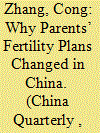| Srl | Item |
| 1 |
ID:
151581


|
|
|
|
|
| Summary/Abstract |
This article examines the parent–child relations within rural-to-urban migrant households to explore the continuations and changes in the patrilineal family system under the forces of migration and urbanization in late-socialist China. Based on ethnographic data collected between 2008 and 2015 in Shanghai, it takes a processual approach to understand son preference as a contextualized family practice and examines four aspects of parent–child relations in migrant households: reproductive strategy, childrearing practices, educational investment, and parental expectation of adult children. Through exploring intimate negotiations between migrant parents and their children over material and emotional resources at different life stages, this article demonstrates how the gendered parent–child relations in migrant households in Shanghai have been shifting away from the traditional focus on sons and gradually giving way to pragmatic adjustments and emotional redefinition under the forces of socialist institutions and capitalist markets.
|
|
|
|
|
|
|
|
|
|
|
|
|
|
|
|
| 2 |
ID:
190412


|
|
|
|
|
| Summary/Abstract |
This article examines the fertility desires, intentions and outcomes of 406 alumni of a middle school in Dalian city, Liaoning province, when they were surveyed in 2014–2015 (during their late 20s and early 30s). It also looks at how and why the fertility desires, plans and outcomes of a 47-member representative subsample and their spouses changed from year to year as they moved through their 20s and 30s between 2008 and 2021. Although most respondents started out wanting two children, longitudinal interviews with the representative subsample and their spouses showed that most gradually resigned themselves to having no more than one child. This was because they felt unable to provide two children with the high standard of living and childcare that their own experiences as singletons had led them to consider essential for proper childrearing.
|
|
|
|
|
|
|
|
|
|
|
|
|
|
|
|